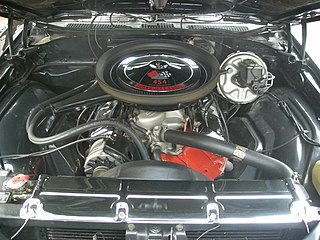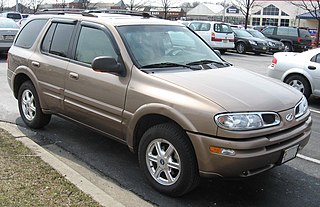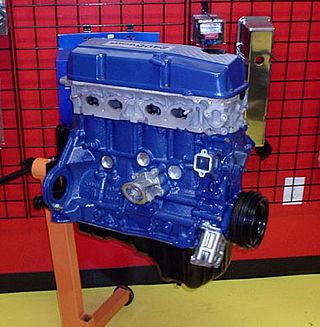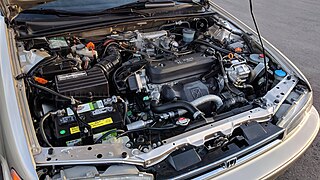
The GMC Envoy is a mid-size SUV manufactured and marketed by General Motors for the 1998 to 2009 model years over two generations. Adopting a nameplate used by GM Canada, the Envoy was a rebadged variant of the Chevrolet TrailBlazer, Oldsmobile Bravada, Buick Rainier, Isuzu Ascender, and Saab 9-7X.

The General Motors LS-based small-block engines are a family of V8 and V6 engines designed and manufactured by American automotive company General Motors. First introduced in 1997, the family is a continuation of the earlier first- and second-generation Chevrolet small-block engine, of which over 100 million have been produced altogether, and is also considered to be one of the most popular V8 engines ever. Spanning three generations, a new, sixth generation is expected to enter production soon. Various small-block V8s were and still are available as crate engines.

The Chevrolet "big-block" engine is a term for a series of large-displacement, naturally-aspirated, 90°, overhead valve, gasoline-powered, V8 engines; that were developed and produced by the Chevrolet Division of General Motors, from the 1950s until present.

The General Motors 60° V6 engine family is a series of 60° V6 engines produced for both longitudinal and transverse applications. All of these engines are 12-valve cam-in-block or overhead valve engines, except for the LQ1 which uses 24 valves driven by dual overhead cams. These engines vary in displacement between 2.8 and 3.4 litres and have a cast-iron block and either cast-iron or aluminum heads. Production of these engines began in 1980 and ended in 2005 in the U.S., with production continued in China until 2010. This engine family was the basis for the GM High Value engine family. These engines have also been referred to as the X engines as they were first used in the X-body cars.

The Oldsmobile Bravada is a mid-size luxury SUV that was sold by Oldsmobile from 1991 to 2004. The only SUV ever marketed by Oldsmobile, the Bravada was the first light truck offered by General Motors outside of the Chevrolet and GMC divisions since 1924. The flagship of the GM midsize SUV line, the Bravada served as the most luxurious GM SUV prior to the introduction of the GMC Yukon Denali and Cadillac Escalade.

The KA engines were a series of four-stroke inline-four gasoline piston engines manufactured by Nissan, which were offered in 2.0 and 2.4 L. The engines blocks were made of cast-iron, while the cylinder heads were made of aluminum.

The 122 engine was designed by Chevrolet and was used in a wide array of General Motors vehicles. The 122 was similar to the first two generations of the General Motors 60° V6 engine; sharing cylinder bore diameters and some parts. The 122 was available in the U.S. beginning in 1982 for the GM J platform compact cars and S-series trucks.

The J-series is Honda's fourth production V6 engine family introduced in 1996, after the C-series, which consisted of three dissimilar versions. The J-series engine was designed in the United States by Honda engineers. It is built at Honda's Anna, Ohio, and Lincoln, Alabama, engine plants.
The GMC straight-6 engine was a series of gasoline-powered straight-six engines introduced in the 1939 model year by the GMC Trucks division of General Motors. Prior to the introduction of this new engine design GMC trucks had been powered by straight-six engines designed by the Buick, Pontiac and Oldsmobile divisions of GM.

GMC has both shared engine designs and architectures with other General Motors divisions as well as having a history of developing and using its own unique engines and powertrains such as its line of straight-6 and V8 engines.

The Chevrolet (S-10) Blazer and its badge engineered GMC (S-15) Jimmy counterpart are compact/mid-size SUVs manufactured and marketed by Chevrolet and GMC from the 1983 through 2005 model years, over two generations – until the early 1990s alongside these brands' full-size SUVs with near identical nameplates, but lacking removable hardtops. From the 1992 model year, GMC's big Jimmy had become the 'Yukon', and so the S-15 prefix was dropped on the smaller GMC Jimmy. Starting with the 1995 second generation, the large Blazer was rebranded as the Chevrolet Tahoe, and these mid-size SUVs were simply launched as the 'all-new Chevrolet Blazer'.

The Honda D series inline-four cylinder engine is used in a variety of compact models, most commonly the Honda Civic, CRX, Logo, Stream, and first-generation Integra. Engine displacement ranges between 1.2 and 1.7 liters. The D Series engine is either SOHC or DOHC, and might include VTEC variable valve lift. Power ranges from 66 PS (49 kW) in the Logo to 130 PS (96 kW) in the Civic Si. D-series production commenced in 1984 and ended in 2005. D-series engine technology culminated with production of the D15B 3-stage VTEC (D15Z7) which was available in markets outside of the United States. Earlier versions of this engine also used a single port fuel injection system Honda called PGM-CARB, signifying the carburetor was computer controlled.

The Honda F-Series engine was considered Honda's "big block" SOHC inline four, though lower production DOHC versions of the F-series were built. It features a solid iron or aluminum open deck cast iron sleeved block and aluminum/magnesium cylinder head.

The General Motors–Detroit Diesel V8 engine is a series of diesel V8 engines first introduced by General Motors for their C/K pickup trucks in 1982. Developed in collaboration with GM subsidiary Detroit Diesel, the engine family was produced by GM through 2002, when it was replaced by the new Duramax line. AM General's subsidiary General Engine Products (GEP) still produces a military variant of this engine for the HMMWV.

The Honda R engine is an inline-four engine launched in 2006 for the Honda Civic (non-Si). It is fuel injected, has an aluminum-alloy cylinder block and cylinder head, is a SOHC 16-valve design and utilizes Honda's i-VTEC system. The R series engine has a compression ratio of 10.5:1, features a "drive by wire" throttle system which is computer controlled to reduce pumping losses and create a smooth torque curve.

The Family II is a straight-4 piston engine that was originally developed by Opel in the 1970s, debuting in 1981. Available in a wide range of cubic capacities ranging from 1598 to 2405 cc, it simultaneously replaced the Opel CIH and Vauxhall Slant-4 engines, and was GM Europe's core mid-sized powerplant design for much of the 1980s, and provided the basis for the later Ecotec series of engines in the 1990s.

The Chevrolet 90° V6 family of V6 engines began in 1978 with the Chevrolet 200 cu in (3.3 L) as the base engine for the all new 1978 Chevrolet Malibu. The original engine family was phased out in early 2014, with its final use as the 4.3 L (262 cu in) V6 engine used in Chevrolet and GMC trucks and vans. Its phaseout marks the end of an era of Chevrolet small-block engine designs dating back to the 1955 model year. A new Generation V 4.3 L (262 cu in) V6 variant entered production in late 2013, based on the LT1 small block V8 and first used in the 2014 Silverado/Sierra 1500 trucks.

The Chevrolet TrailBlazer is a mid-size SUV produced by Chevrolet, a division of General Motors. The nameplate was first used in North America from 2001 to 2008; in 2009, it was replaced by the Traverse, as a crossover SUV. In 2011, production of a newly-redesigned version of the Trailblazer for the Asian and Brazilian markets began.



















